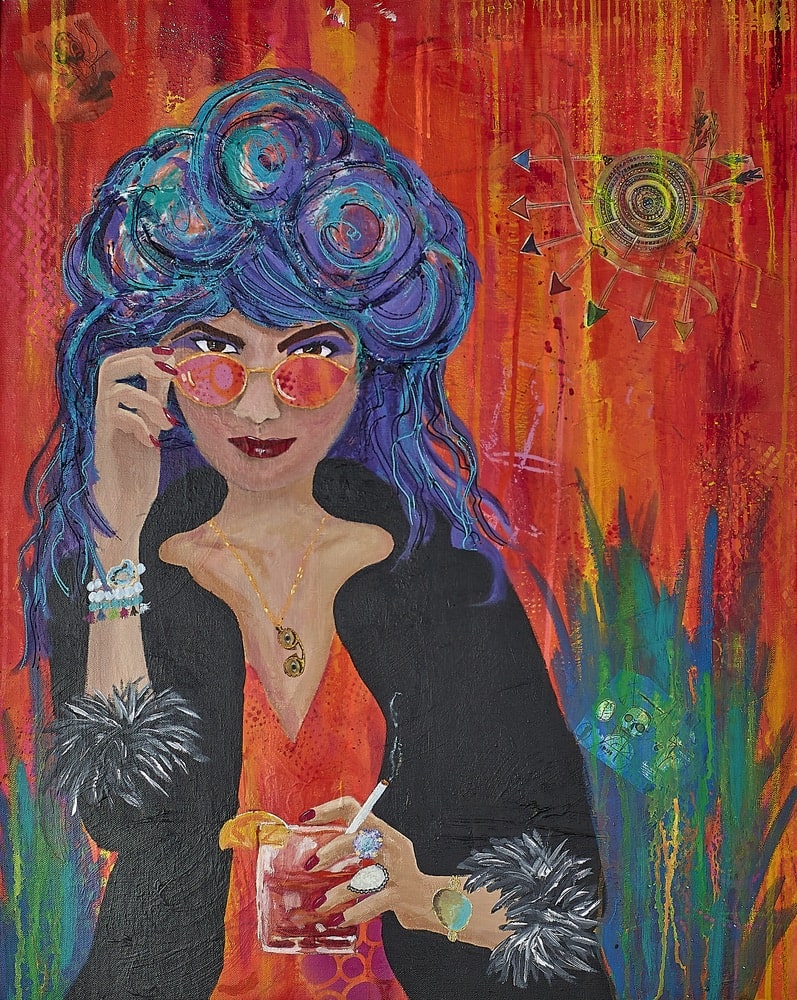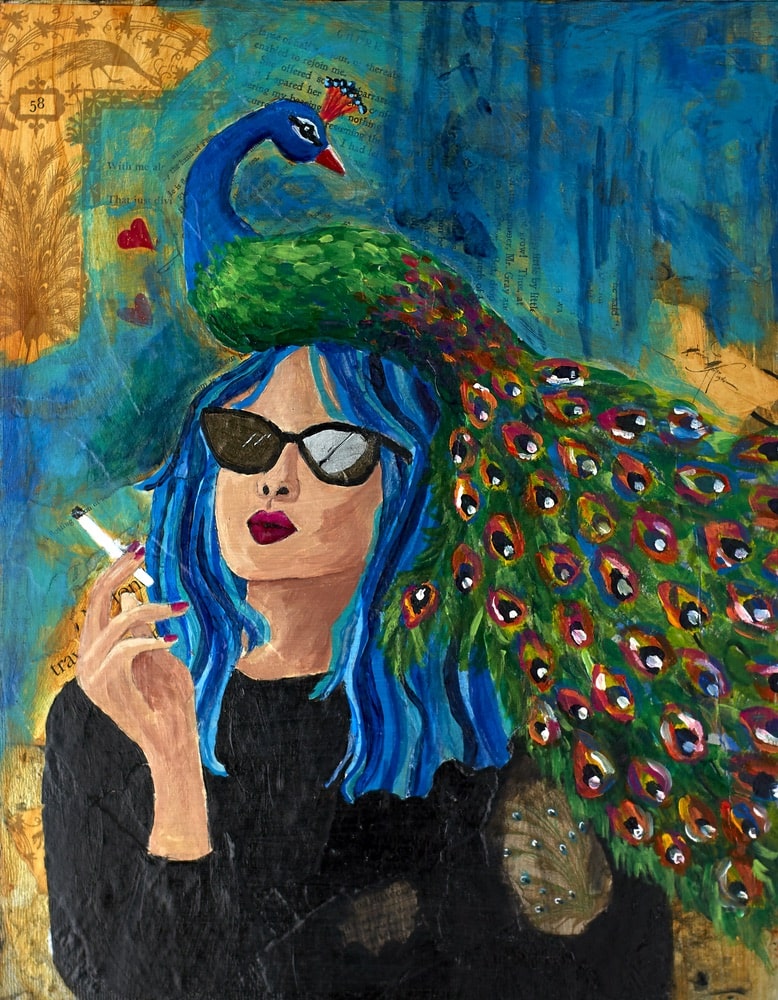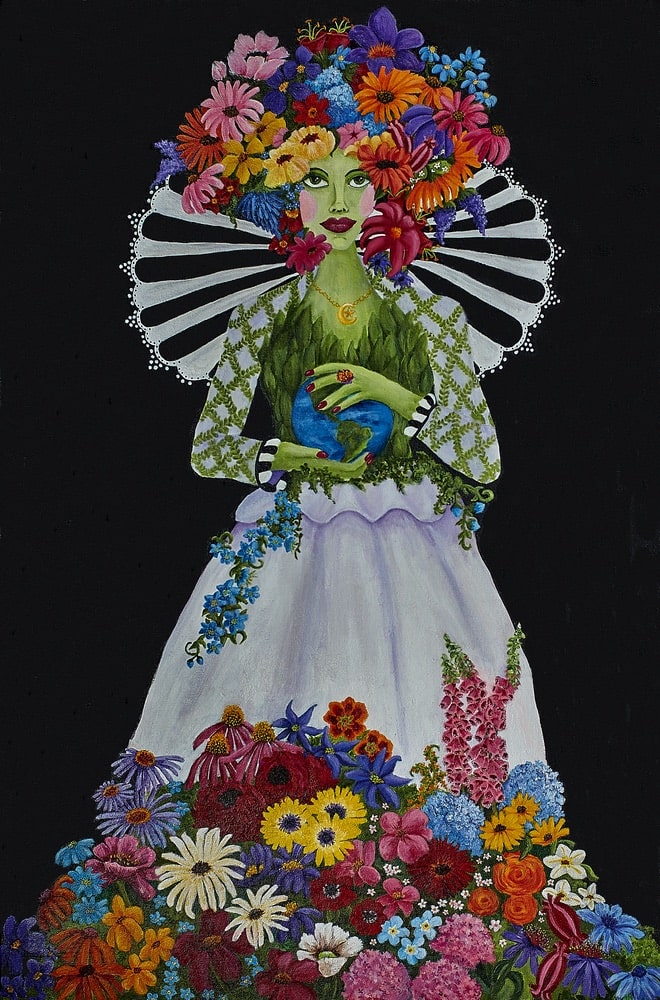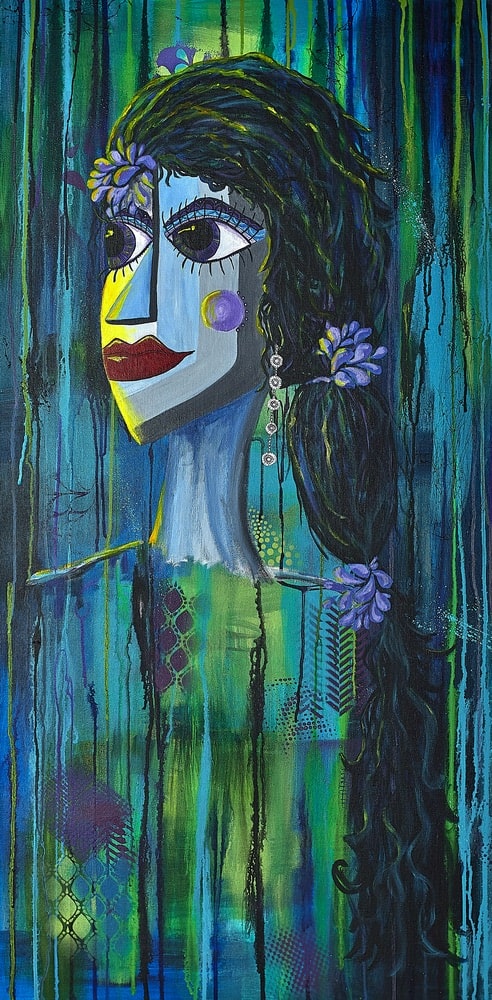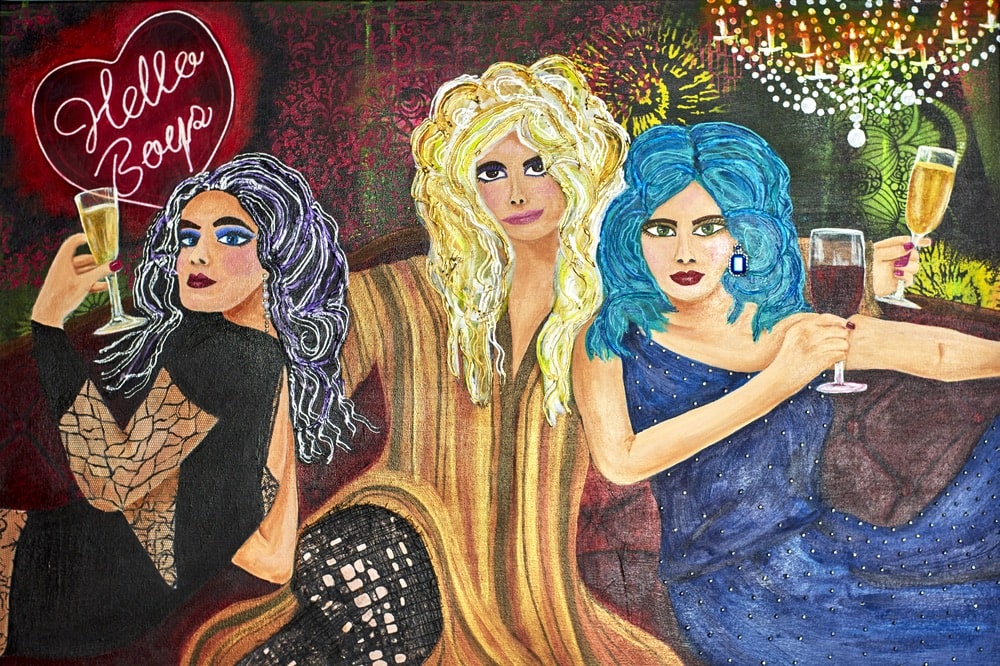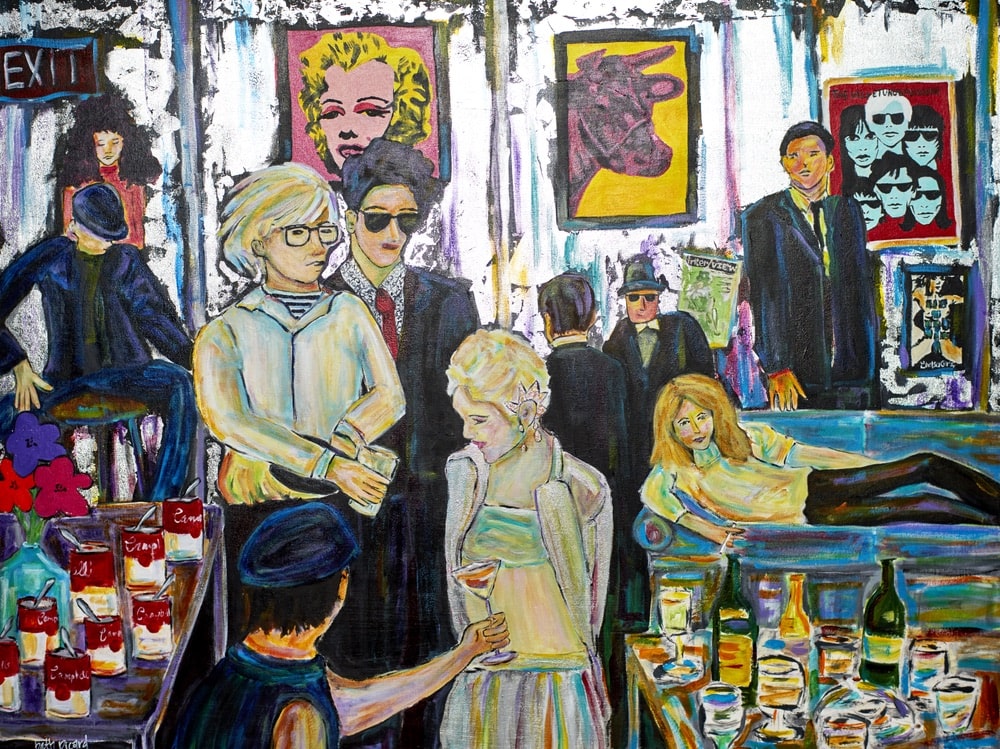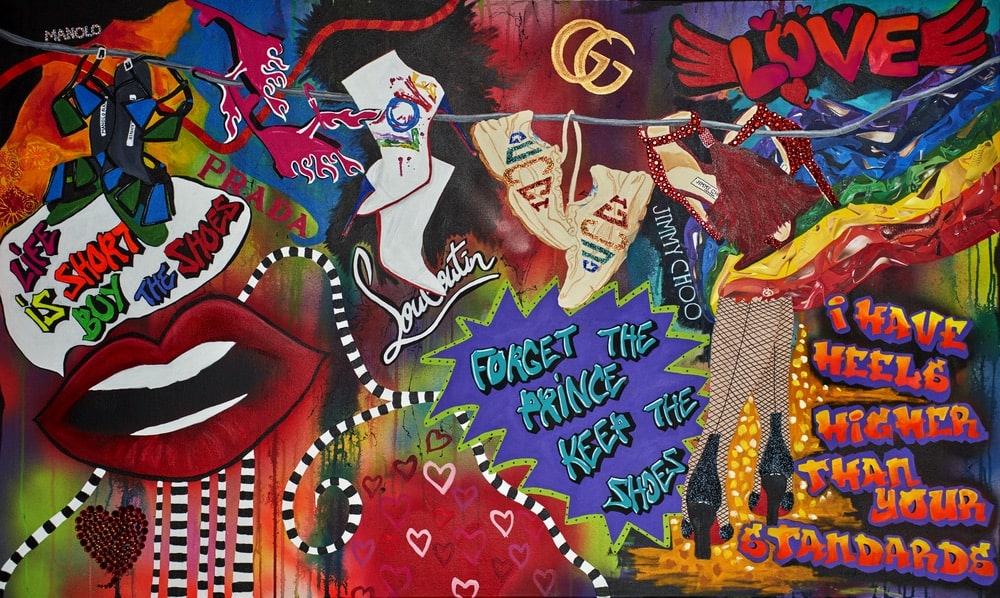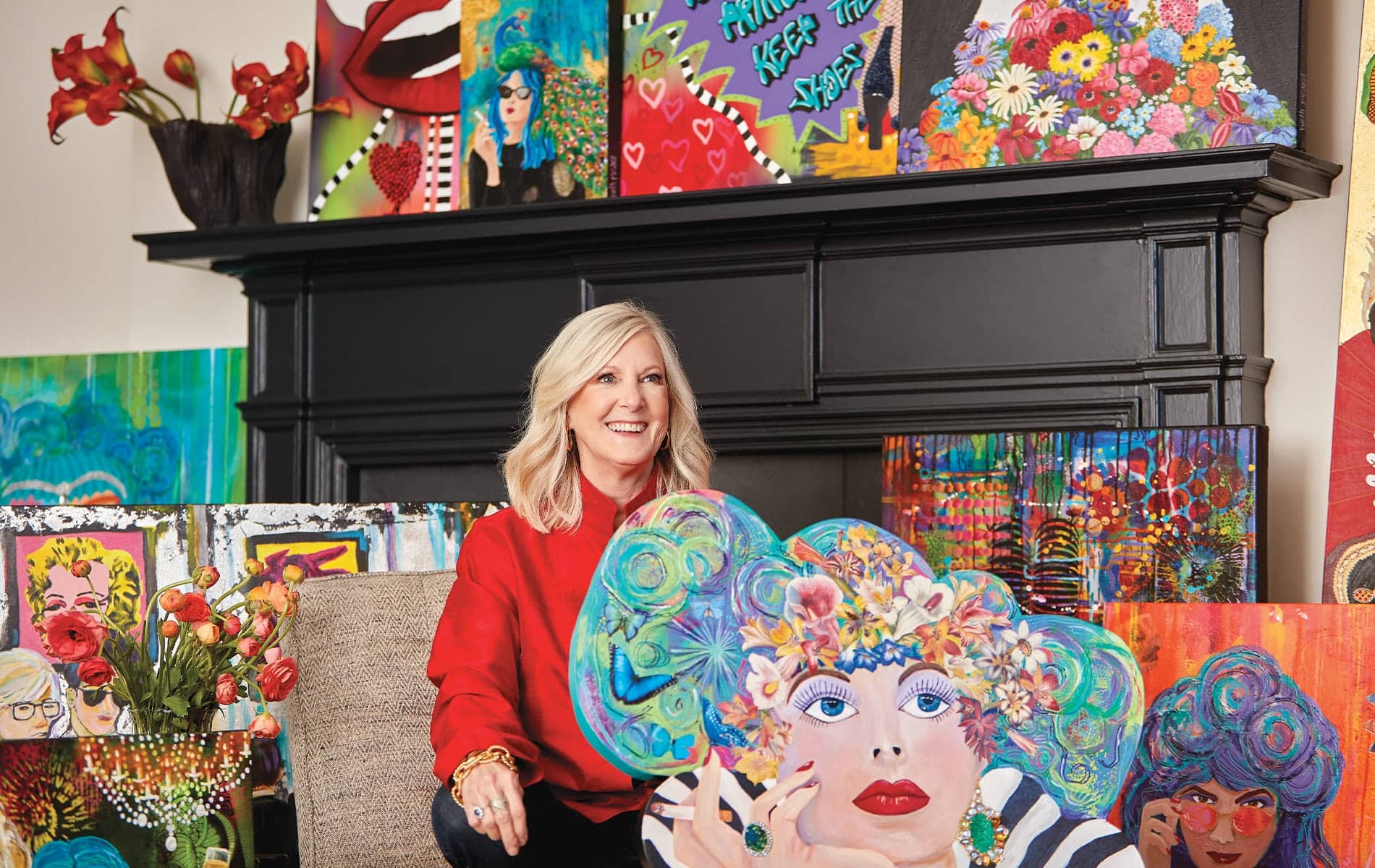
vie-magazine-beth-picard-art-hero-min
Artist Beth Picard with her painting You're Boring Me, Dahling | Mixed media on handmade canvas, 27.5 × 36 in.
Painting for the Joy of It
By Sallie W. Boyles | Art by Beth Picard | Photography by Paul Jones
“Henri Matisse is my favorite painter ever,” says Beth Picard, referring to the twentieth-century French artist. “He always used such great colors.” A kindred spirit, Picard especially relates to the range of Matisse’s work. “When I went to Nice and visited his museum,” she reveals, “I wanted to stay there. He built dollhouses, made sculptures, did tapestries. He was all over the place, and it hit me that he did all these things.”
Picard, too, has produced art in many forms, but until her Matisse-inspired epiphany, she thought her tendency “to get bored and move on to do something else” was a “bad personality trait.” Two years ago, when she was close to turning sixty, another jolting moment of clarity led her to focus full-time on painting—but only things that brought her joy.
Throughout her life, Picard has sketched and painted, a gift she inherited from her father. Her first teacher, he also passed along great tips, such as how to make a grid drawing of Donald Duck. “He can paint a bird that looks like it could fly off the page,” Picard says, claiming her skills were never quite so refined. “I can’t draw faces,” she insists. (Evidence suggests otherwise!)
With her mother and father’s support, Picard was six when she began taking art lessons in her hometown of Opelika, Alabama. “Miss Rosalyn was wonderful,” Picard recalls of the teacher she had until high school. “She never said anything was bad.” If something wasn’t working, then Miss Rosalyn inspired a fresh approach.
- You Talkin’ to Me? | Mixed media on gallery wrap canvas, 30 × 24 in.
Picard’s grandmother, a.k.a. Gaga, also had a “profound effect” on her work. “She was always asking me if I was painting,” Picard relays, “and said a million times, ‘God didn’t give you this talent for you to waste it.’ She commissioned a painting of her poodle from me and hung it in her bedroom. What I painted was the scariest looking animal, but she didn’t care!”
Gaga wasn’t her only patron. “My very first entrepreneurial job was painting the backs of denim shirts,” says Picard, who was then still in high school. “All the women in Opelika wanted them.” Industrious from the start, she expresses, “Nobody ever said to me, ‘Oh, you’re not going to get a real job if you’re an artist.’”
A tyrannical professor at the University of Alabama, however, derailed her plan to major in art. “He was one of those nightmares you hear about,” Picard says. “He threw a bunch of trash—hay and other things—on the floor and said, ‘Draw this.’ I had never been around anyone who acted like that.” To graduate on time, she settled on a degree in advertising. Upon realizing that art directors were hiring only art majors, Picard found her own opportunities.
“I absolutely could not do what I am doing without him. He is my encourager. He is my biggest fan.”
Interior designers in Birmingham, for instance, commissioned her to paint floor cloths. “When I had my own business,” she says, “I did hand-painted designs on children’s clothes.” For a period, Picard designed and crafted ceramic pieces. Working with mosaics, she made decorative sinks for a real estate developer and benches for a retailer. She didn’t treat it seriously, but in the nineties, Picard wrote and illustrated a children’s book, The Bedside Table, chosen as a book of the month by Birmingham’s Books-A-Million. From 2002 to 2009, she ran her own wholesale business of designing and manufacturing high-end stationery, which is how Picard and her husband (“number three’s the charm”), Alan, met. By 2011, Picard had taught herself enough about digital graphics to create designs for clients to use on products they sold. When they asked for instructions, Picard produced a hundred how-to videos that she offered through a subscription.
She next created fresh artwork for her merchandise, such as beach towels, leggings, luggage tags, and baby bibs. (The leggings are still available through her website.) “I probably had fifty or sixty items that I was making myself,” she says. Picard admits to working eighteen-hour days and being miserable, yet says, “I wasn’t planning to shut down the business.”

Wild Women of the World | Mixed media on gallery wrap canvas with 2.25-inch painted sides, 16 × 72 in.
Her reality check arrived while on a beach trip/birthday getaway with her husband, children, and grandkids. Alan, who would typically surprise her with flowers and gifts, had nothing. With her chaotic schedule, he hadn’t counted on the vacation, much less time to celebrate. That’s when Picard said, “Okay, I’m shutting it down.” Regarding Alan, she contends, “I absolutely could not do what I am doing without him. He is my encourager. He is my biggest fan.”
Because of him, Picard took a leap of faith back to painting. “My mother saw me as a huge risk-taker,” she says. “I don’t see myself as a risk-taker at all. I’ve never thought that anything I’d ever do would fail. I don’t do failure.” A big believer in the Law of Attraction, Picard says, “What you put out, you get back. If you put out negative, you’re going to get negative.” Talent is another undeniable factor, and her work ethic is extraordinary. Picard still works from nine to four, seven days a week.
“If you paint what you like,” she insists, “it will show through your painting.” She currently has three main series: Throws a Party, Smoking Hot Women, and Wild Women. In case people are wondering, she says, “There’s no secret meaning. I’m not that deep.”
- Mother Earth | Acrylic on gallery wrap canvas, 24 × 36 in.
Ideas for her paintings do play on her subconscious, sometimes materializing in dreams, as with Andy Throws a Party, an homage to Andy Warhol. “I dreamed up the Warhol party because I love parties,” she shares. Naming him among her favorite artists, Picard points out, “I’d never painted a realistic face.” Telling herself, we’re just going to do this, she confides, “I painted everything else first because then I was too committed to the painting to stop.”
The collage series also includes Ashley Throws a Party, a tribute to someone Picard greatly admires, fellow Alabama-born artist Ashley Longshore (“Pop Art’s Rebel Queen,” VIE, May 2018). “My sister told me to follow her,” says Picard, confessing that she “stalked” the artist online. From learning about her, Picard incorporated the people and things Ashely loved. “I had no idea if she would ever see it,” Picard says. To improve her odds, she tagged Ashley’s team when she posted a photo of the finished painting on Instagram. Immediately, Ashley commented that she wanted to buy the piece. They arranged for Picard to bring it to Ashley’s gallery, where she pronounced, “This has everything in it I love!”
For someone who doesn’t do faces, Picard gives her women highly expressive features; their eyes speak volumes.
For someone who doesn’t do faces, Picard gives her women highly expressive features; their eyes speak volumes. “When I start one,” Picard says, “she’ll tell me who she is, what color of hair she wants, and I’ll go from there.” They amuse her so much that Picard’s often laughing while working, making Alan wonder what’s so funny. “If she’s not talking with me, then I’ll put her aside,” Picard notes. “If she’s in a bad mood and doesn’t want to be painted that day, she has to sit in the corner!”
She loves it when her paintings “speak” to others. “E.J. Nobles, who owns the 1842 Inn with his partner in Macon, Georgia, just bought his twelfth painting from me,” she informs. “He has been my greatest collector. I mean, even my mother wouldn’t hang twelve of my paintings in her house!”
- Hello Boys | Mixed media on gallery wrap canvas, 24 × 36 in.
- Andy Throws a Party | Andy Warhol tribute | Mixed media on gallery wrap canvas, 36 × 48 in.
It’s a good thing Picard works on several paintings at a time! Refusing to wait more than twenty minutes for the paint to set, she appreciates that acrylic dries quickly and that “you can cover it up. I love that I can layer it with Japanese papers.” When finished, she puts her signature on the side, and signs and dates the back with the title. “Seeing someone’s big signature on a painting is distracting to me,” Picard says. “There are no distractions if my name is not on it.”
“I’m not a rule follower,” Picard proclaims, choosing, for instance, to show and sell her work almost exclusively through her website, BethPicard.com. At the same time, she welcomes collaborations. Plans are under way for designer Chloé Kristyn (ChloeKristyn.com) to debut a “Mother Earth” kimono (with a graphic of Picard’s painting on the back) in the 2019 holiday collection. Likewise, subscribers to Suthingirl (Suthingirl.com), which fills seasonal and luxury gift boxes with curated Southern-branded merchandise, can soon anticipate Picard’s artwork on items like jewelry trays and hand-painted silk scarves.
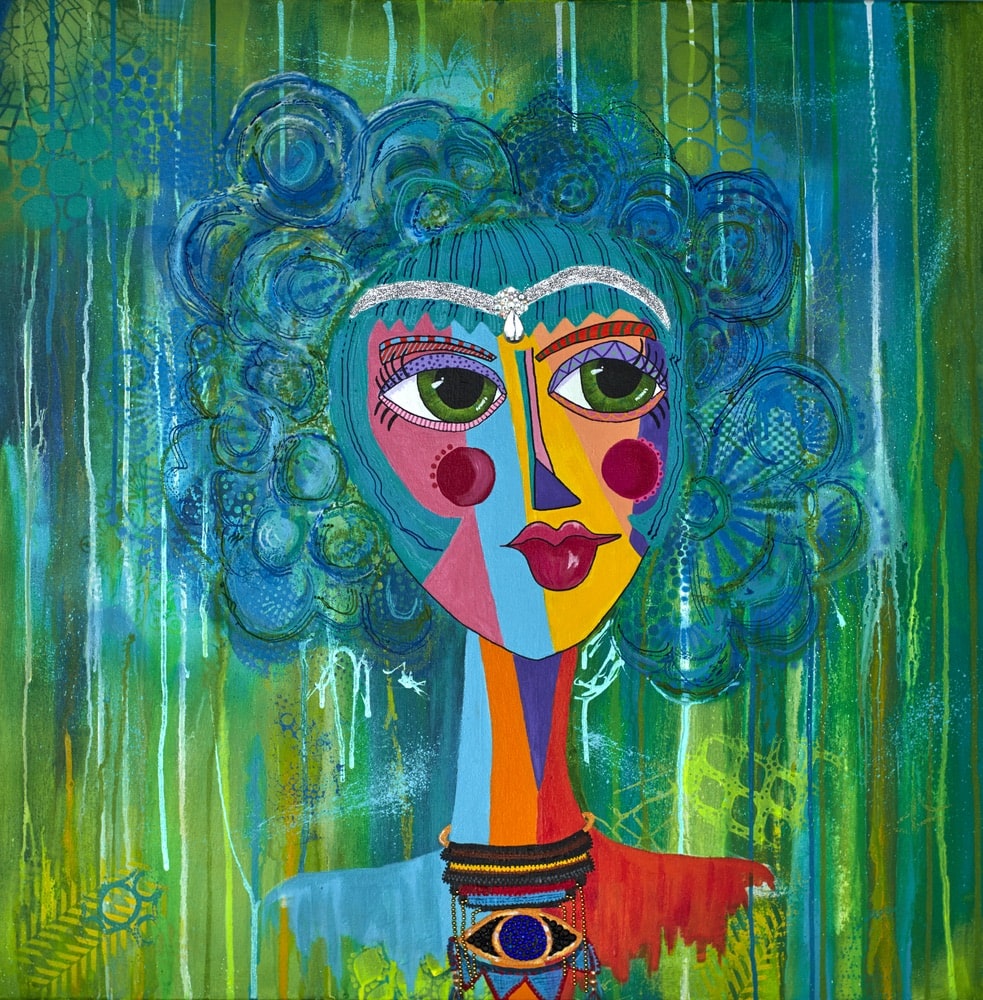
Serena the Seer | Mixed media on gallery wrap canvas with 1.5-inch painted sides, 30 × 30 in.
Given the breathing room to paint and spend time with her extended family, Picard also loves to encourage young artists, including her granddaughter Liza, to paint for the joy of it. “If she wants black grass, that’s fine,” says Picard. “Somebody burned the yard!”
Many talented people also follow Picard on Instagram and seek her guidance about painting techniques, artwork pricing, and more. If they can’t believe she’s graciously shared her phone number, Picard says, “Do you think I’m some celebrity? I’m never that busy!” Ultimately, she’d love to sell enough of her work to help up-and-comers financially until their art can sustain them.
Considering all who’ve been there for her, Picard concludes, “You put out good, and good’s going to come back.”
— V —
Visit BethPicard.com to see more or to inquire about purchasing Picard’s art.
Sallie W. Boyles works as a freelance journalist, ghostwriter, copywriter, and editor through Write Lady Inc., her Atlanta-based company. With an MBA in marketing, she marvels at the power of words, particularly in business and politics, but loves nothing more than relaying extraordinary personal stories that are believable only because they are true.
Share This Story!
KEEP UP WITH THE LATEST STORIES FROM VIE



